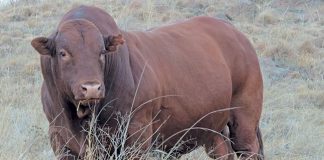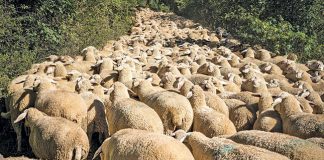Several important factors affect a calf’s weaning weight:
Environmental and external factors
- Quality and quantity of nutrition – This includes forage plant species (natural veld or planted pasture) influenced by season, rainfall, soil type, temperature; supplementary feeding (creep, hay, silage and licks); and stocking rate.
- Temperature and humidity
- Rearing status of the calf: Single/twin, suckling mother or hand-reared calf.
- Internal and external parasites, and treatment (dosing or dipping).
- Diseases and treatment (including inoculation).
- Injuries and treatment.
- Other management interventions, including: Dehorning, branding and castration.
- Other factors, such as a dam with fewer teats.
For comparisons to be fair and accurate, only calves subjected to the same environmental conditions and receiving the same nutrition, management and treatment can be compared.
Sex of calf
Male calves are, on average, about 8% heavier than heifer calves at weaning. For a fair comparison, only compare calves of the same sex. If they are compared across sex, adjust their weights for the effect of sex.
Age of calf at weaning
Generally, older calves will be heavier than younger calves. For this reason, compare only calves born within a certain period (100 days, for example). Their age should also be within specified limits (for example, 151 to 270 days). Within such a group, adjust actual weaning weights to a constant age (for example, 205 days) for a fair comparison.
Age of dam
Calves of mature cows (about five to 10 years) are heavier than calves from young cows and, to a lesser degree, old cows.
To enable a fair comparison, adjust weaning weights to a mature cow basis according to the age of the dam.
Other factors
Other factors, such as production history of the cow – for example a cow that failed to calve or rear a calf the previous year – could influence its calf’s weaning weight, as a cow could accumulate additional reserves, resulting in higher milk production.
Genetic factors
Assuming proper adjustments, the contemporary grouping as well as weight and age of the dam, and other variation in weaning weight within the group, will reflect the genetic differences between animals.
This genetic variation can be separated into two components:
- The genetic merit of the calf for its pre-weaning growth rate;
- The genetic merit of the dam for maternal ability (milk production and nurturing of the calf).
Contemporary groups
How do you use this to compare calves’ performance? A basic principle in comparing the weights of a group of calves is to compare apples with apples. Therefore, the performance of a calf is usually defined by comparing its weight with the average weight of its contemporaries.
A contemporary group is a group of animals born in the same season of the same year (similar age range), at the same location (farm and herd), of the same sex, with the same rearing status, and managed alike (feeding and treatment) from birth to weaning. A properly defined and uniform contemporary group is one of the most important factors in fair and accurate comparison of animal performance.
In general, guidelines on contemporary groups are aimed at ensuring that all (or at least all significant) environmental effects (such as the year, season, farm, herd, sex, rearing status, management and feeding) are the same for all animals within a particular group.
Basic Records
To compare calves’ weaning weights, ensure that a few basic aspects are in place:
- Identify the calves (and their dams). Ear tags, ear notches and branding are the most common ways to properly identify animals.
- Keep basic records of all animals. The minimum are the ID number, sex, birth date and the dam’s ID number.
- Ensure that your cattle scale is in good working order and correctly calibrated.
- Weigh all calves born within a three-month period on the same day when their average age is about seven months. This practice will minimise the influence of seasonal differences such as rainfall or veld condition on the weights. However, you don’t need to wean all these calves on the day of weighing – wean younger calves a month or so later.
- Weigh animals early in the morning before they have a chance to drink water (or leave them overnight in a kraal without water) to minimise the influence of gut fill on their weight.
The National Beef Recording and Improvement Scheme of the Agricultural Research Council (ARC) applies the latest technology in recording practices, data verification and processing to calculate performance indices and breeding values where applicable. The same technology is applied in the BeefPro beef cattle management software for farmers, which is marketed by the ARC.
For more information on the ARC’s National Beef Recording and Improvement Scheme and/or BeefPro, contact Leslie Bergh on 012 672 9145, 082 801 2026 or email [email protected]












